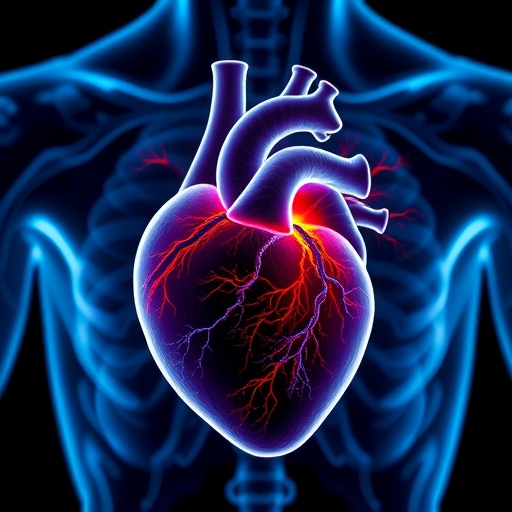In the complex landscape of cardiovascular health, the heart’s ability to adapt to heightened workloads plays a critical role in sustaining life. One such adaptive mechanism is cardiac hypertrophy, a process characterized by the thickening of the ventricular walls. Typically, this response acts as a protective strategy, allowing the heart to manage increased pressure and maintain function without immediate detrimental effects. However, when the underlying stressors persist chronically, this initially adaptive process can transform into pathological hypertrophy, precipitating severe structural changes such as ventricular dilatation, impaired cardiac function, and ultimately heart failure.
Among the populations vulnerably affected by cardiac overload, individuals with type 2 diabetes mellitus (DM2) stand out with elevated risks for heart failure. This predisposition stems from coexisting conditions common in diabetes, including hypertension, obesity, and coronary artery disease. These comorbidities exacerbate cardiac stress, accelerating the transition from adaptive to pathological cardiac hypertrophy. Understanding the molecular underpinnings that govern this transformation can illuminate novel therapeutic avenues for preventing heart failure in these high-risk groups.
A landmark study recently published in the highly respected journal Cellular and Molecular Life Sciences has shed light on a previously underappreciated molecular player in this pathological transition: the protein GADD45A (growth arrest and DNA damage inducible 45A). This multifunctional protein, known primarily for its role in stress signaling and genome integrity, is now implicated in the intricate regulation of cardiac remodeling processes. The research, conducted by a collaborative team including Professors Manuel Vázquez-Carrera and Xavier Palomer from the University of Barcelona, marks a pivotal advancement in cardiovascular biology.
The study comprehensively utilized both in vivo animal models and in vitro human cardiomyocyte cultures to delineate GADD45A’s role in cardiac function. Importantly, the investigation focused on mechanisms central to pathological hypertrophy, such as inflammation, fibrosis, mitochondrial dysfunction, calcium-handling dysregulation, metabolic alterations, hypertrophic growth of cardiomyocytes, and apoptotic pathways. Fibrosis and inflammation emerged as critical determinants in the progression of cardiac deterioration, tightly linking molecular pathology to the clinical decline observed in heart failure patients.
Intriguingly, mice genetically engineered to lack GADD45A exhibited pronounced cardiac fibrosis and inflammatory infiltration, underscoring the protein’s protective role. These mice also demonstrated significant cardiac hypertrophy with associated morphological and functional deficits, highlighting GADD45A’s importance in maintaining cardiac integrity under stress. Molecular analyses revealed a hyperactivation of key proinflammatory and profibrotic transcription factors, including activator protein-1 (AP-1), nuclear factor-kappa B (NF-κB), and signal transducer and activator of transcription 3 (STAT3), upon GADD45A deletion. This signaling cascade likely orchestrates the deleterious remodeling characteristic of pathological hypertrophy.
Complementing these findings, experiments involving human AC16 cardiomyocytes showed that overexpressing GADD45A partially abrogated the inflammatory and fibrotic responses triggered by tumor necrosis factor-alpha (TNF-α), a well-known proinflammatory cytokine elevated in cardiac disease states. This suggests that enhancing GADD45A activity might counteract the maladaptive cellular milieu that precipitates cardiac dysfunction. The dual evidence from murine and human cellular models reinforces the therapeutic potential of targeting GADD45A pathways.
Beyond its cardiovascular implications, GADD45A has drawn scientific attention due to its broader roles in cellular homeostasis. Historically characterized as a tumor suppressor involved in DNA repair and cell cycle regulation, GADD45A’s functions extend into metabolic regulation and protection against oxidative stress. Prior research has implicated this protein in modulating catabolic and anabolic pathways, as well as mitigating fibrotic and inflammatory processes in diverse organ systems. This multifaceted profile positions GADD45A as a promising therapeutic target not only for cardiac diseases but also systemic metabolic disorders such as obesity and diabetes mellitus.
The current study’s groundbreaking insights into GADD45A’s cardioprotective functions represent a significant stride in unraveling the molecular intricacies of heart disease. If further validated in clinical settings, strategies to upregulate or mimic GADD45A activity could revolutionize treatment paradigms for patients at risk of heart failure, especially those burdened by diabetes-related cardiac complications. Moreover, the mechanistic clarity around AP-1, NF-κB, and STAT3 signaling provides valuable molecular targets for adjunctive interventions.
Professor Manuel Vázquez-Carrera, reflecting on the study’s clinical relevance, emphasized the critical connection between fibrosis, inflammation, and disease progression in pathological hypertrophy. Fibrosis particularly correlates strongly with adverse patient outcomes, making its prevention a pivotal goal in cardiovascular medicine. Meanwhile, Associate Professor Xavier Palomer highlighted how GADD45A’s ability to suppress inflammation, fibrosis, and apoptosis could preserve cardiac function and stave off the onset of heart failure.
As researchers continue to explore the multifaceted roles of GADD45A, this work lays a foundational framework for future investigations. The interplay between genetic regulation, cellular stress responses, and metabolic conditions underscores the complexity of cardiac remodeling. Ongoing research will be essential to translate these molecular findings into safe and effective therapies, with the promise of mitigating one of the most pervasive causes of morbidity and mortality worldwide.
In summary, the identification of GADD45A’s protective role in cardiac health opens exciting avenues for combating pathological hypertrophy and heart failure. Through meticulous experimental approaches, this study enhances our molecular understanding of cardiac remodeling and underscores the therapeutic promise of modulating stress-responsive proteins. As the global burden of heart disease rises in tandem with metabolic disorders, such pioneering research is vital for developing targeted, effective treatments that can transform patient outcomes.
Subject of Research: Animals
Article Title: GADD45A suppression contributes to cardiac remodeling by promoting inflammation, fibrosis and hypertrophy
News Publication Date: 30-Apr-2025
Web References: 10.1007/s00018-025-05704-x
Keywords: Diseases and disorders




